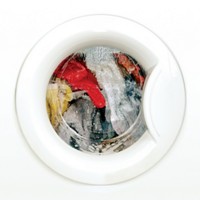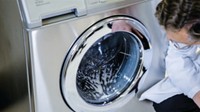Advertisement
Grab your lab coat. Let's get started
Welcome!
Welcome!
Create an account below to get 6 C&EN articles per month, receive newsletters and more - all free.
It seems this is your first time logging in online. Please enter the following information to continue.
As an ACS member you automatically get access to this site. All we need is few more details to create your reading experience.
Not you? Sign in with a different account.
Not you? Sign in with a different account.
ERROR 1
ERROR 1
ERROR 2
ERROR 2
ERROR 2
ERROR 2
ERROR 2
Password and Confirm password must match.
If you have an ACS member number, please enter it here so we can link this account to your membership. (optional)
ERROR 2
ACS values your privacy. By submitting your information, you are gaining access to C&EN and subscribing to our weekly newsletter. We use the information you provide to make your reading experience better, and we will never sell your data to third party members.
Business
Wash-Day Strategy
Makers of cleaning products see innovation as the way out of an economic fog
by Michael McCoy
February 20, 2012
| A version of this story appeared in
Volume 90, Issue 8

Despite some brightening on the economic horizon, “significant clouds of uncertainty” still loom, creating hardship for consumers and putting them on the lookout for value in the products they buy.
That was the sobering outlook delivered by Jeffrey P. Ansell, chief executive officer of the laundry detergent maker Sun Products, at the American Cleaning Institute’s (ACI) annual meeting in Orlando earlier this month.
U.S. retail sales of cleaning products have been flat to declining for the past several years, Ansell said. “The bottom line is the economically pinched consumer today is contributing to the slowest growth in wash loads in years,” he told a breakfast session at the ACI conference.
But ever optimistic, Ansell declared that the solution to anemic growth is innovation to meet the needs of empty-nest baby boomers who are downsizing and millennials who want time-saving products. He and other executives at the conference insisted that breakthroughs in ingredients and product forms can get their industry back on the growth path.
In particular, Ansell and Robert A. McDonald, his CEO counterpart at rival Procter & Gamble, are putting a lot of faith in a new breed of single-dose laundry detergents (C&EN, Jan. 23, page 15). Sun’s entry into the field, All Mighty Pacs, are already on store shelves, Ansell reported, and P&G’s Tide Pods are not far behind. “Single-dose pods and tablets will increase category growth,” McDonald said.
At the meeting, chemical companies that make ingredients for cleaning products were taking a cue from their customers and also emphasizing innovation. “The economic situation doesn’t decrease the drive for innovation,” said Lionel Genix, global marketing director for Dow Chemical’s home and personal care business. “In this economy, the winners are bigger winners than before and the losers are bigger losers.”
It’s not yet clear on which side of the ledger single-dose detergents will fall. On the one hand, they advance a trend in product compaction and could help simplify the cacophony of product types that clutter the detergents aisle in retail stores. On the other hand, single-dose products are expensive to manufacture. “They will need to get the price-performance equation right,” Genix said.
Dow is targeting some of its new ingredient technology at the single-dose detergents, all of which are liquids. Although Genix wouldn’t be specific, he noted that Dow recently introduced Acusol 845, an acrylic terpolymer antigraying additive specially designed to work in liquids. Current antigraying agents, which prevent dirt from redepositing on clothes in the wash, are ineffective in liquids, he said, because they interact unfavorably with rheology modifiers.
Evonik Industries is particularly attuned to economic vicissitudes because its main products for the cleaning industry are active ingredients for fabric softeners, which, unlike detergents, are discretionary products that consumers can forgo when times get tight. Despite a healthy first half of 2011, Evonik noticed business start to weaken in the fourth quarter, said Steve Turner, household care business line director for the firm’s consumer specialties division. Business is likely to remain soft through the first half of 2012 and then pick up in the second half, Turner predicted.
In keeping with the innovation theme, Evonik used the ACI meeting to introduce a new fabric softener active ingredient that can be formulated at room temperature. Turner noted that most softener actives, part of a category of cationic surfactants known as ester quats, are solids or pastes that have to be heated for formulating.
Potential buyers of the new active ingredient are the handful of U.S. fabric softener manufacturers that never switched to ester quats from older dialkyl quat technology, in part because of the formulation challenges. Customers in developing countries without expensive heating and mixing equipment are also target users.
BASF executives at the meeting touted the opportunities for innovation they are finding in the enlarged cleaning products ingredients portfolio created through the acquisition of the German specialty chemical maker Cognis a little more than a year ago. Gabriel Tanbourgi, head of the firm’s care chemicals division, pointed in particular to cross-fertilization between BASF’s petrochemical-based portfolio and Cognis’ oleochemical-based one.
For example, BASF is offering customers in the dishwashing detergent market its Trilon M chelating agent, an aminocarboxylate replacement for phosphates in machine-washing products, as well as natural-source Glucopon alkylpolyglucoside surfactants for hand-washing products made by the former Cognis. “Having both value chains under one roof helps generate cross-innovation,” he said.
The economic headwinds won’t get in the way of developing new products and formulas, according to Tanbourgi. “Innovation is still on the agenda,” he said. Customers seek innovations that bring convenience, quality of life, and sustainability. And, he said, they also ask: “How can I reduce my costs through innovation?”
Tom Nelson, director of customer business development at P&G Chemicals, described the current economic environment as VUCA: volatile, uncertain, complex, and ambiguous. After feeble business in late November and December as customers tried to draw down inventories to keep them off their books at year’s end, January brought a surge of buying to restock. “This is a VUCA consequence,” he said.
Like other companies that manufacture oleochemicals, P&G Chemicals tries to maximize output of 12- and 14-carbon fatty alcohols and methyl esters, key starting materials for surfactants, and then devotes energy to finding homes for coproducts with longer or shorter chain lengths.
A recent success story, Nelson said, is an agreement to provide short-chain esters to the Danish firm Agowa Bio Solutions. The esters will replace paraffins as an ingredient in candlelike lamps that are popular in Europe but have caused poisoning of children who drank the lamp oil. The arrangement helps P&G balance its oleochemical operations while providing Agowa with a nontoxic, vegetable-derived lamp oil.
In a nod to the conference theme, Nelson said P&G Chemicals is working with customers on further innovations that will increase use of short- and long-chain fatty alcohols and esters. “They’re available, and they’re going to be competitive,” he said. “It’s worthwhile to invest the R&D resources to formulate with them.”





Join the conversation
Contact the reporter
Submit a Letter to the Editor for publication
Engage with us on Twitter